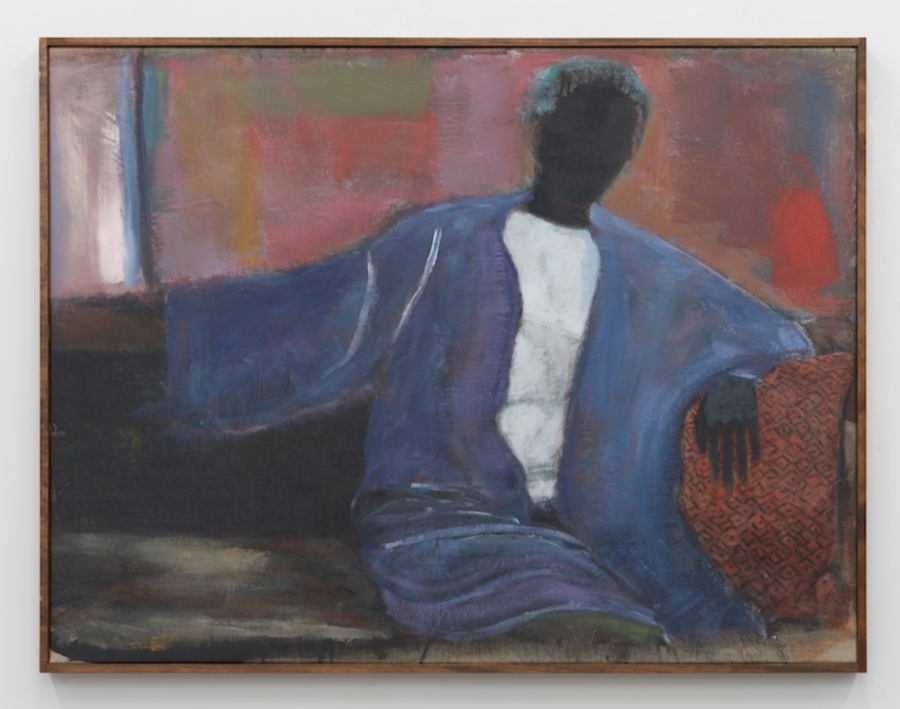February 2021
Download as PDF
View on Whitehot Magazine

Reggie Burrows Hodges, Seated Listener: Orange Pillow, 2020. Courtesy of the artist and Karma, New York.
Reggie Burrows Hodges’s paintings hum with an energy that is at once gripping and elusive. Born in Compton, California and based in Maine, the artist creates poetic vignettes derived from scenes he has observed in everyday life. Yet Hodges’s paintings do not consent to be pinned down by time, space, or gravity.
Hodges’s show at Karma gallery, his first solo show in New York, wraps two full galleries in a cloak of hauntingly subdued beauty. The magnetism of these paintings lies largely in Hodges’s distinctive technique, which is both aesthetically and politically imaginative. Based in negotiating Blackness as a color, form, and ethic, Hodges’s technique introduces a new kind of tenebrism to art history: he begins each work by grounding the canvas with opaque Black paint, subsequently adding gauzy layers of color, but leaving the space his figures occupy black. Their faces, devoid of features, refuse our gaze, shirking the demands for access and legibility that the world presses onto Black people. Hodges thus rouses strikingly interior silhouettes from negative space, using blackness to fundamentally challenge our conception of what color, light, and depth can achieve. “I start with a black ground [as a way] of dealing with blackness’s totality,” the artist is quoted saying in the catalogue essay by Hilton Als. And this is irreducibly felt in each of his paintings: blackness is both the ground and the figure in Hodges’s work, at once form and limitless expanse.
The paintings in the gallery at 172 East 2nd Street resound with a vertigo that is at once terrifying and filled with possibility. Collectively titled On the Verge, these intimate, small-scale scenes give form to the feeling of suspension. Weight slips away and we are left somewhere in the unsettling caesura between stillness and movement. In a pair of paintings titled On the Verge: Going Away and On the Verge: Going Forward (both 2020) figures riding unicycles tumble through an elliptical jumble of brushstrokes, arms akimbo in gestures that suggest the fraught elegance of a balancing act. In the lower right corner of both works, Hodges has left visible swathes of black paint which simultaneously ground the scene (literally) and signal a groundless negative space. This slippage surfaces again in On the Verge: Green Field (2020). A solitary figure gazes towards the sky. Black skin runs up against the tones of a glowing sun. The painting captures a moment that feels unimpeachably still, yet the figure seems to teem with energy: tantalizing black paint smolders through the layers of color, on the verge of leaping forward from its own shadow. To call upon the words of Calvin Warren, Hodges’s black invokes the “strange juxtaposition between…formlessness and form” that characterizes Black existence. This interplay seeps through Hodges canvasses. I felt almost certain that at any moment the figures, who materialize from the black, could steal away into it.
After a short walk to 188 East 2nd Street, we encounter another sanctuary of arresting fantasias at Karma’s second location. The back of the gallery is bejeweled with small portraits set in domestic environments that evoke Jacob Lawrence’s Migration Series (1933) in their subversive combination of emotional gravitas and bare compositional aesthetic. The works at the front of the gallery, dramatic in size, yet reserved in mood, left me stopped in my tracks. Reminiscent of Charles Burnett’s classic film Killer of Sheep (1978), Hodges’s Hurdling: Green (2020) stages an endless ascent that feels at once serene and euphoric. We witness an athlete caught suspended midair, his shadowy arms and legs stretched beyond the picture frame in either direction. Deliberate but airy yellow brushstrokes accelerate and electrify the composition. The ground is excluded from view and with it any sense of gravity. Hodges floods the painting with the dream of escape, and Black fugitivity echoes interminably in the blurring of figure and air. A nearby portrait titled Seated Listener: Orange Pillow (2020) depicts a figure deep in rapturous intimacy with music. The figure’s arms are draped over a couch, relaxed yet balletic, while a concert of muted pinks and greens—one of Hodges’s many masterful chromatic arrangements—plays in the background. Though the sitter’s visage is obscured, their posture unmistakably conveys the kind of “bone-deep listening” that Fred Moten talks about in describing the relationship between Blackness and sound. In this painting and many others, Hodges requires a bone deep attention from us. The paintings absorb us in depth, suspend us in limitless grounding and ungrounding, perhaps to the point of letting us slip into the black. WM



